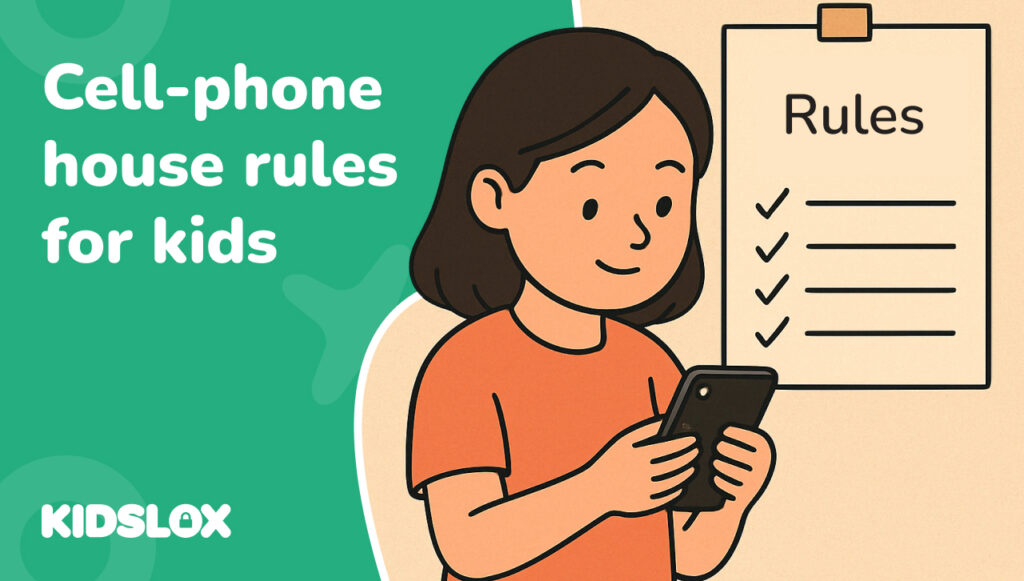It’s 6 PM on a Tuesday. The living room looks like a toy store explosion.
Your youngest is watching YouTube at full volume while your oldest refuses to set the table because “it’s not fair” that they always have to do it. You’ve asked three times for homework to be started, and somehow, you’re the bad guy for insisting on basic responsibilities. Sound familiar?
You haven’t failed at parenting. You might just be missing a clear framework that everyone understands and follows.
House rules for kids aren’t about creating a rigid, joyless environment where children march in formation. They’re about establishing predictable patterns that actually reduce stress for everyone.
When children know what’s expected, they spend less energy testing boundaries and more energy feeling secure enough to thrive. And when parents aren’t constantly making case-by-case decisions about behavior, they can focus on enjoying their family rather than policing it.
Let’s walk through how to create, implement, and maintain family rules that foster responsibility, respect, and yes – even fun!
Why Have House Rules?
Children naturally crave boundaries, even when they push against them.
Think of house rules as the walls of a playground. They define a safe space where kids can play freely without constant supervision or correction. Without those walls, children actually feel less free, not more, as they’re never quite sure where the danger might be or when they might be in trouble.
House rules help kids understand not just what’s expected of them, but why those expectations exist. When a child knows that “we speak kindly to each other” is a family value, they begin to internalize empathy and respect rather than simply avoiding punishment for name-calling.
For worn-out parents, established house rules mean you’re not reinventing the wheel with every situation. The mental load of parenting decreases when you’re not constantly making and explaining new decisions. “We don’t jump on furniture” becomes an understood principle, not a battle to be fought each afternoon.
Remember that house rules aren’t just about controlling behavior – it’s about life skills. The child who learns to hang up their backpack is developing habits of responsibility. The teenager who respects screen-free dinner time is learning the value of presence and connection.
Getting Started with Creating Family Rules
The thought of establishing formal house rules might feel overwhelming, especially if your household has been operating without clear guidelines for some time. The key is to start small and build gradually.
Begin with just 3-5 fundamental rules that address your family’s most pressing challenges.
Is mealtime chaotic? Start there. Are mornings a struggle? Focus on a morning routine first.
By targeting specific pain points, you’ll see immediate benefits that motivate everyone to continue.
Get Family Buy-In
One of the most effective strategies for gaining buy-in is involving all family members in the rule-creation process.
Even young children can contribute meaningful input when asked, “What would help our family work better together?” This more collaborative approach transforms rules from top-down restrictions to shared agreements that everyone has helped design.
Make Them Age-Appropriate
Remember that rules should be age-appropriate. A 4-year-old and a 14-year-old need different guidelines and explanations for why those guidelines matter.
For younger children, keep rules short, concrete, and phrased positively: “We use walking feet inside” rather than “No running in the house.” For teens, focus on the reasoning behind rules and be open to negotiation on non-safety issues.
Wording Matters
The wording of your house rules makes a huge difference in how they’re received.
Compare “No screentime until homework is done” with “Finish responsibilities before entertainment.”
The second approach teaches a life principle rather than just a restriction. When possible, frame rules to emphasize what to do rather than what not to do.
The Core Categories of Important Family Rules
Safety forms the foundation of any family’s rule system. Start with basic home safety rules like “Always wear a helmet when riding bikes” or “Ask an adult before using the stove.”
Outdoor boundaries deserve special attention in your safety rules. Consider guidelines like “Stay where you can see our house” for younger children or “Always text when you arrive at a friend’s house” for teens.
Safety rules should also address interactions with others. “We don’t open the door unless a parent is with us,” or “We don’t share personal information online,” help children navigate potential dangers.
While you don’t want to frighten children, frame these rules as empowering rather than scary: “These rules help you know exactly what to do in tricky situations.”
Respect Rules
Respectful communication forms the cornerstone of a harmonious household. Consider rules like “We speak with kind words” or “We ask before borrowing someone else’s belongings.” These guidelines teach children essential social skills that serve them throughout life.
Personal space deserves explicit protection in your family rules. “Knock before entering bedrooms” or “Ask for a hug rather than assuming” teaches children about consent and boundaries.
Active listening deserves its own category in your respect rules. “We put down devices when someone is speaking to us” or “We don’t interrupt” teaches children that others’ thoughts and feelings matter. These seemingly small courtesies build the foundation for meaningful relationships both within and beyond the family.
Responsibility Rules
A 4-year-old might help set the table while a 10-year-old loads the dishwasher, but both contributions should be valued equally. Consider creating a simple chore chart that rotates responsibilities, preventing the “it’s not fair” complaints that frustrate many parents.
Taking care of personal belongings teaches children respect for material things and organizational skills. Rules like “Toys get put away before bedtime” or “Backpacks get unpacked when you come home” create routines that gradually become automatic. When these expectations are consistent, children eventually internalize them as habits rather than chores.
Homework and school responsibilities deserve their own category in your household rules. Consider guidelines like “School assignments come before leisure activities” or “Backpacks and lunch boxes get prepared the night before.”
Time management rules help children learn to navigate their day successfully. “We leave for school at 7:45 every morning” or “Bedtime routine starts at 8 PM” creates the predictable rhythms that help children feel secure. Use visual timers or schedules for younger children who don’t yet have a strong sense of time.
Screen Time Rules
We all need clear technology boundaries. Rules like “One hour of recreational screen time on weekdays” or “Devices charge overnight in the kitchen, not bedrooms” can help children develop self-regulation around technology use.
Content guidelines should be explicit in your family’s screen time rules. “We only watch age-appropriate shows” or “Parents approve all app downloads” helps children understand that not all digital content is created equal.
Establishing tech-free zones and times creates space for family connection. “No phones at the dinner table” or “Tech-free Sundays until noon” might meet initial resistance, but often become a cherished family tradition.
For parents feeling overwhelmed by monitoring digital usage, parental control apps can provide helpful support.
Tools like Kidslox make enforcing screen time limits and content restrictions easier without constant supervision. While technology shouldn’t replace conversations about healthy tech habits, it can certainly make enforcement more manageable for busy parents.
Tips for Implementing Your New Rules
Use Visual Reminders
Rules that exist only in conversation rarely stick. That’s why using visual reminders reinforces expectations without requiring constant verbal reminders.
For non-readers, consider using pictures that represent each rule: a toothbrush for “Brush teeth morning and night” or a clock for “Bedtime is 8 PM.”
Stay Consistent
Consistency forms the cornerstone of successful household rules. When parents enforce guidelines sometimes but not others, children receive mixed signals that inevitably lead to testing boundaries. This doesn’t mean being rigid—occasional special circumstances are part of life—but the general pattern should be predictable enough that children know what to expect.
Use Consequences – Not Punishments
When rules are broken (and they will be), focus on natural consequences rather than punishments. If a child refuses to wear a coat and gets cold, the natural consequence teaches more effectively than an arbitrary punishment.
When natural consequences aren’t practical, logical consequences work well: “Since you didn’t clean up your toys as agreed, they’ll need to take a break for the rest of today.”
Celebrate The Wins
Perhaps most importantly, celebrate when rules are followed. Our attention often gravitates toward broken rules, but acknowledging success reinforces positive behavior.
A simple “I noticed you put your dishes in the dishwasher without being reminded! That really helps our family” goes further than elaborate reward systems. Positive reinforcement helps rules feel like achievements rather than restrictions.
The Most Important Rule? Be a Good Role Model Yourself
Children learn more from what we do than what we say. If you scroll through social media while insisting on device-free family time, the disconnect is obvious even to young children.
This doesn’t mean parents don’t get adult privileges. It’s reasonable for adults to stay up late or have different responsibilities.
However, core family values like respectful communication, responsibility for belongings, and present engagement during family time should apply to everyone. When children see parents living by the same principles they’re taught, the message becomes infinitely more powerful.
Being a good role model also means showing grace when mistakes happen, including your own.
When you lose your temper or forget a responsibility, acknowledging it models accountability: “I shouldn’t have raised my voice. I need to follow our family rule about speaking respectfully.” This teaches children that rules aren’t about perfection but about continuous effort and repair when we fall short.
Adapting Rules as Children Grow
Family rules aren’t set in stone. As children develop, their capabilities and needs change dramatically. A great way to analyze and adapt your rules is by scheduling regular family meetings to revisit your household guidelines and discuss what’s working and what might need adjustment.
As children demonstrate responsibility and age appropriate behavior, gradually increase their autonomy. Some rules will naturally phase out while others will evolve. “No crossing the street alone” eventually becomes “Text when you arrive at your destination.”
Recognizing when to relax certain rules requires parental discernment. Some boundaries, such as safety rules, remain non-negotiable. Others, especially those related to personal preferences or methods of responsibility fulfillment, can flex as children mature.
House Rules Can Make A Difference!
Creating house rules for kids isn’t about controlling their every move or stifling their natural joy. It’s about providing the framework within which childhood can flourish safely and joyfully.
When children understand expectations, they waste less energy testing boundaries and spend more time developing confidence, creativity, and character.
Start small with just a few essential rules in areas that most affect your family’s harmony. Keep young kids involved in the process and always be consistent in their application. Remember that your own modeling speaks volumes – your children watch what you do far more closely than they listen to what you say.
Remember that the boundaries you establish today don’t limit your child’s potential. They are laying the foundation for future success by teaching values, responsibility, and respect that will serve them throughout life.
Creating rules may require initial effort, but the long-term benefits are well worth the investment. Your family doesn’t need military precision or perfect compliance. You simply need a shared understanding of how your unique family functions best together.
So take a deep breath, gather your family, and start the conversation. You’ve got this.
Want to learn more great tips on building a healthy and thriving family life in the modern age? Check out our full library of guides and resources online – and learn how tools like Kidslox can help you bring a bit of structure and sanity to a wild world!





